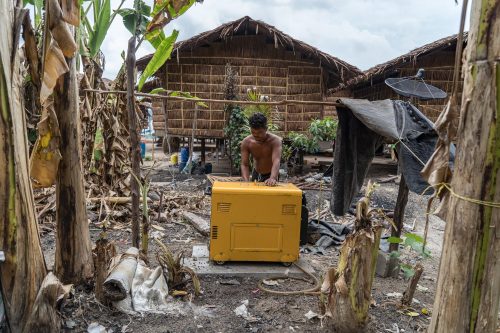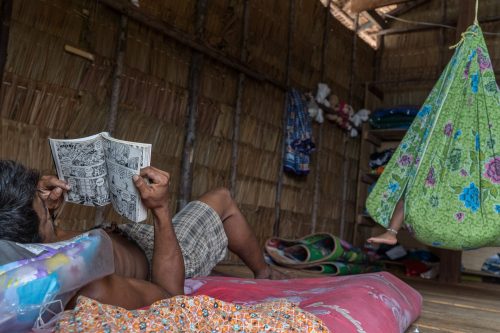Tourism and restrictions on land use and marine resources have altered the livelihoods of sea gypsy communities in Thailand and impacted the environments where they’ve settled.
The Moken gained some media attention back in February after a large fire swept through a dense village of stilted homes in Au Bon Yai Bay, Surin Island Marine National Park. The fire exposed the precarious lifestyle lived by the Moken, an indigenous group commonly known as “sea gypsies” that reside along the shoreline of the Indian Ocean, from the south of Myanmar toward the Philippine archipelago.
It didn’t take long to re-build the village homes, with the military pitching in. But in interviews, many Moken say a house is “not a solution,” both because it doesn’t suit their way of life and goes against their traditional belief system. The new structures are still crowded together, defying the sense of solitude that the Moken say they prefer.
But such are the conditions imposed on the Moken if they want to continue living in the area that is also a national marine park.
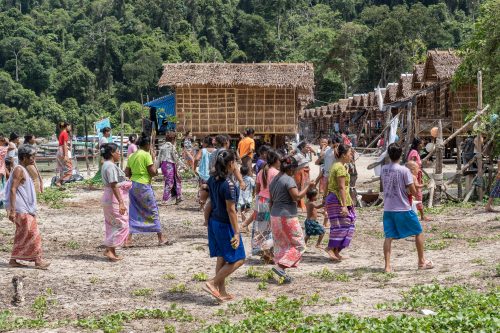
The Moken are part of a larger group that includes the Moglen and Urak Lawoi, each of which has its own language. For generations, the Moken lived at sea as nomads without a formal leader. In order to obtain citizenship in a modern state, they needed to settle down along the coasts or in marine parks – though many remain stateless.
But under marine park regulations, it’s proven difficult for the Moken to keep their indigenous identity and continue to access the natural resources they depend on to make a living. They rely on fishing for household consumption, but to afford other expenses many Moken people in Surin Island have become employees for the Marine National Park and for tourist companies in the area.
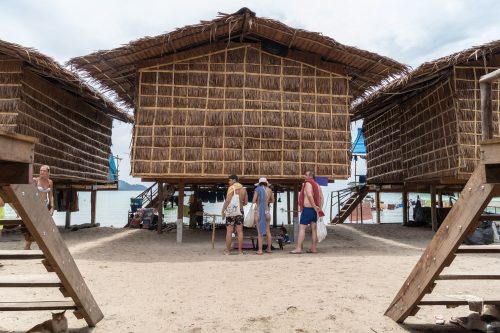
Moken villages are open for tourists to visit and see their way of life. In exchange, some sell crafts they make as souvenirs. But this source of income they can earn only in high tourist season from October to April. During monsoon season, they depend on fishing nearby the shoreline.
“Sometimes it feels like we are in a human zoo for the tourists to visit,” Ngoei–Tawan Klatalae, a young Moken man, said about the downside of tourism.
He complained about people walking around in swimming suits, going in and out of villagers’ homes as if they were open to the public.
“It is obscene. I have told the tourist companies about it and asked for cooperation about the appropriate tourist outfit. But it doesn’t get that far,” said Huke–Suriyan Klatalae, Ngoei’s brother.

he growth of tourism has raised other concerns among community members about issues like waste management and the impact visitors will have on the natural environment. Tourist companies often give bottled water and tin cans to the villagers as gifts, for example, but that creates waste that they must dispose of.
For now, they collect and separate the biowaste, which they bury, from the plastic waste, which they transport to the mainland land where they sell it to a garbage factory. They use the money to buy necessities, such as spices and dried food, that will help them through the monsoon season.

Assistant Professor Dr. Thon Thamrongnawasawat, Vice Dean of the Faculty of Fisheries at Kasetsart University, said there has to be strict monitoring to ensure plastic waste doesn’t end up in the sea, and if there is an increase in tourists there needs to be a better method to deal with biowaste. One possible solution that he’s discussed is to use a compost machine.
Compared to other places, Dr. Thon is not particularly worried about Surin’s environment. He said the island is recovering from coral bleaching caused in part by El Nino. The bleaching has led to a dramatic decline in the number of tourists, he said. In the past there, some Moken violated marine park laws and caught marine life to sell to tourists.
“That problem was solved with [good] cooperation by the villagers,” Dr. Thon said. “In the present, there is fishing for subsistent living not for commercial. Although when we interpret the law directly, they cannot fish, it is negotiable because it is a traditional way of life. It can be compromised.”
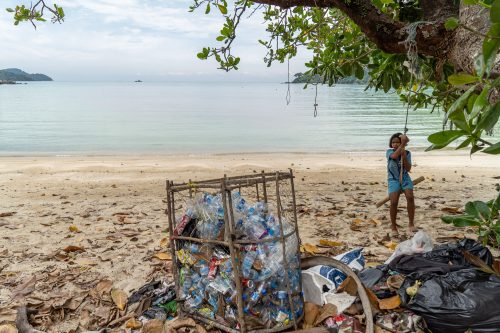
Puthapoj Kooprasit, Director of Surin Island Marine National Park, sees tourism as a benefit to the Moken since they are able to earn an income by being employed by the park or by tourist companies. And they can sell souvenirs to tourists without getting involved in illegal activity or disturbing natural resources.
“If the natural resources are still abundant and in good condition, the tourists will come and Moken people will have jobs to do,” Puthapoj said.
He admitted that he did have some concerns about the environmental impact of some tourist behavior. Some tour companies feed the fish in order to get close to them, he said, and some tourists take up the fish in order to take a picture. In the long run that will change fish behavior.
“For this matter, we always put restrictions,” Puthapoj said. “If we find it happening, we will call the tourist companies to talk and make them understand. In recent times, this matter [has declined].”

Villagers say the other thing they worry about is the illegal entry of commercial fishing boats into the marine park, and they’ve raised their concerns with park officials for stronger monitoring and enforcement of vessels that engage in illegal fishing.
“To be straightforward, Surin Island is in the good situation in terms of environmental management because there is a combination of cooperation from the government agencies, which enforce the law, and Moken people living in the area,” said Dr. Thon. “Surin Island has a management model that is at a satisfactory level and can be replicated for other marine national parks.”

Without protections, a different scenario
The situation is different in Rawai Bay in Phuket Province, where locals have been locked in a well-known land dispute with investors. The fight is currently in the court but far from reaching a solution. In the meantime, the health and quality of life for the Moken of Rawai, which is also impacted by the environment and ecosystem of the shoreline, has gotten less attention.
Rawai beach is home to around 2,000 sea gypsies, comprising both Moken and Urak Lawoi, though it is unclear how many belong to which ethnic group. For decades they have fought together for their land, a factor that has united them – particularly the younger generation. The lack of ethnic distinction has led to an increase in migration from elsewhere, particularly because Phuket serves as an important economic area and tourism is the vein of the city.
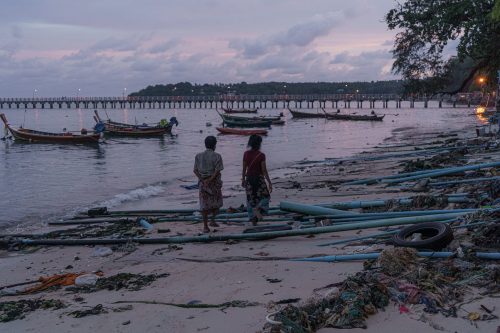
But because of the density of the population and a lack of rights to the land, the Rawai community cannot access basic infrastructure. There are no sewers and a shortage of toilets and other sanitation facilities. The lack of a discharge pipe has caused waterlogging in the community. In the rainy season, water flows into villagers’ houses. The waterlogging has become a source of diseases, such as dengue fever, say residents. There is a clear increase in conjunctivitis and diarrhea, especially in the rainy season, said Nirand Yangpan, a community leader of the sea gypsy in the area.

Dr. Thon said the clearest indication of the environmental impact caused by population growth and a lack of proper resource management in Rawai is the disappearance of the pencil-spine sea urchin.
“Wherever you walked, you found plenty of them,” he recalled. “The villagers used to make a mobile decoration from it because when its shells hit, it makes a nice sound. Later on, when more tourism came into the area, the community expanded and more pencil-spine sea urchin are brought for sale.”
The lack of proper waste management by the growing community and commercial businesses in the area also posed a threat to the pencil-spine sea urchin since it’s sensitive to environmental change. “From easily seen, the pencil-spine sea urchin in Rawai has not been seen no more,” said Dr. Thon. “For me, this is clearly the environmental change indication.”
Because the Rawai area is not part of a Marine National Park, there is little law enforcement can do both in the sea and on the land to stop activities that threaten the surrounding natural resources. It doesn’t help that people have few alternative livelihoods.

Dr. Thon said he created a campaign and went around explaining to the sea gypsies that certain species like parrotfish are important for the coral reefs and should not be fished.
“But the parrotfish is not in the list of protected animals,” he said. “It is not illegal, so people sell it until today. I try to understand the villagers’ situation, but in terms of academic information, it is hard to say that the parrotfish has been way decreased. This is because it is not a commercial fish so there has not been any intensive study about the number of this kind of fish. As a diver, it is clear that the fish has declined sharply. It has a direct impact on the marine ecosystem,” Dr. Thon concluded.
Nowadays, sea gypsies in Rawai rely on shellfish like abalone and other fish that they sell to seafood markets and seafood restaurants along Rawai beach.

But fishing for these marine animals can be highly dangerous. Decompression sickness is the most terrify. “Before I used to dive deeper into the sea without diving equipment to assist me,” said Liew Lakkoh, a community leader in Rawai beach. “I used to dive more than 10 meters [in] depth.”
At that depth, divers will often find lobster and sea cucumber. But Liew said he only dives to 3-4 meters now due to the dangers. Even though he earns less income, it is also less risk.
Without citizenship or land rights, these sea gypsies have little to support them. For the Moken of Surin, tourism may be one means of survival – for both them and the environment – but it doesn’t come without consequences.











